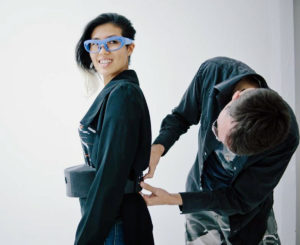 British fashion designer Hussein Chalayan recently partnered with Intel to give the clothes in his new show that little added something—electronics that monitor stress levels.
British fashion designer Hussein Chalayan recently partnered with Intel to give the clothes in his new show that little added something—electronics that monitor stress levels.
This can only have been for both companies to show off a little, especially for Intel to make a fashion case for its Curie module, an itty-bitty computer. Chalayan has previously commented that “Only with technology can you create new things in fashion. Everything else has been done.”
Surely anyone with a modicum of common sense and even the most oblique understanding of the fashion industry would assume that show models are under a lot of stress. There are the quick changes, walking in shoes designed for display only, keeping that size 0 figure, and facing an audience and your boss at the same time. Not exactly a Zen situation.
And at this show, there was the added stress of having your stress level projected for all to see–or the case of one dress, roses flapping to the beat of the model’s anxiety level. And all the while you are strutting your and Chalayan’s stuff, you’re trying to reduce stress by breathing in for six counts, out for four—a technique that predates the technology by a couple of millennia. Basically, it was biofeedback with an audience.
Still, the technology itself is more interesting than the use to which it was put. It involves two devices, a pair of glasses and a 3-D printed belt. Powered by a Curie module, the glasses include an optical heart sensor and a microphone in the nose piece, and EEG electrodes in the temples. The biometric data is Bluetoothed to the belt, which has its own Curie module as well as an Intel Compute Stick that allows the belt to project the data onto a wall as animation via a pico projector.
We’re not seeing a whole lot of real-world use for this, although in the medical field, it could be useful for monitoring those who can’t speak for themselves; e.g., infants, coma patients, animals. That could be done without the projector or the fancy outfits. As far as seeing this technology in clothing at your local Macy’s or J.C. Penney, don’t hold your breath. But if it does show up on the racks, at least there it should be in clothing a typical woman might actually wear in public.